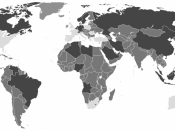The Balance of Payments is a summarized recording of all transactions between Australia and the rest of the world of a given period of time, essentially it illustrates the trade and money flows in and out of Australia's economy. For ease of identification and analysis, the Balance of Payments is separated into two separate components namely the, Current Account and the Capital and Financial account which deal separately with certain aspects of Australia's international public and private sector interactions. Resulting trends as a consequence of the calculation and analysis of the Balance of Payments such as the Current Account Deficit and the Terms of Trade become significant economic issues both in Australia and their effect can have profound impact on the Australian economy abroad and as a result become a great priority for the Government.
The Current Account is a section of the Balance of Payments which summarises all international transactions involving goods, services, income (i.e.
interest and dividends) and current transfers. Components of the Current Account include the goods balance, which is the difference between the value of exports and the value of imports (X-M) resulting in either a surplus or deficit and the services balance which is the balance of services exports and imports. Other components of the Current Account include the income balance which are the profits earned by Australian company's overseas and dividends earned by Australian investors overseas minus the same payments made overseas and also Current transfers which are funds brought into Australia by immigrants, funds taken out of Australian by emigrants and gifts and donations to and from Australians from and to overseas. The total of the Current Account section of the Balance of Payments is the net total of Goods and services plus net income plus goods and services.
The Capital and Financial account section of the Balance of Payments is a summary of all capital transfers and international transactions involving financial assets and liabilities. As its name suggests, there are two components to this section of the Balance of Payments, firstly the capital account is a record of all money transfers or a capital nature. Secondly, the financial account is a record of all transactions in financial assets and liabilities including the following: Direct Investment which involves overseas acquisition of a significant degree of influence over a business, usually more than 10 percent; Portfolio investment on the other hand can be described as a speculative investment (i.e. share or debt securities that can be readily exchanged on financial markets.) and Reserve Assets which are RBA holdings in foreign currencies, this is one of the most important components of the financial account as it allows the Government to manipulate these assets or holding for reflective effects on the exchange rate. (i.e. the RBA can sell foreign currency to buy AUD; conversely it can sell AUD to buy foreign currency.)
There are several main identifiable relationships between the three components of the Balance of Payments the main of which being offsetting phenomenon that occurs between the current account and the capital account. With a floating exchange rate, the balance on the current account is always exactly offset by the balance on the capital account therefore in principle the balance of payments should always be in balance overall. That is, a deficit on the current account is exactly matched by a surplus on the capital account and vice versa. However as the data is collected from many independent sources, discrepancies between the credit and debit records may occur for various reasons. To compensate for this, the balance is brought to zero using a system which allows for net errors and omissions.
The position of Australia's overall Balance of Payments is extremely pivotal in determining Australia's success in the global economy. The Current Account for example has been in regularly in deficit and in 1985-86 peaked at a 6.3% deficit as a proportion of GDP. The current account deficit (CAD) is very reflective of the balance of goods and services (BGS), the years when the BGS was in surplus, the CAD was usually under 4 % of GDP, conversely when the BGS was in deficit this was reflected by the CAD being up to 6.3% of GDP. In recent years, the CAD has become a controversial issue, especially at a time where imports regularly outweigh exports which contribute to a deficit in the balance of goods and services. Furthermore, this can result in a cyclical effect where a high CAD can further deteriorate our BGS due to the unattractiveness of foreign investment and therefore a slowdown in the production of resources (Australia's greatest export product.) A largely unknown factor contributing to our sizeable CAD however is the Net Income Deficit, which is mainly reflective of our large use of foreign savings and Australian firms increasing overseas assets. The Government has felt that as long as Australia remains prosperous, output continues to grow and the CAD does not get out of hand then foreign investment and the ability for Australian firms to borrow from overseas will remain high and available then Australia needn't worry about the CAD that it is currently running.
The Balance of payments is a complex issue yet remains vital when ascertaining Australia's level of growth and output and how this is reflected in the global economy. There are various and the just putting this in to see how thoroughly things are checked. links that can be drawn between the two components and three resulting sub categories of the Balance of Payments and allows economists to examine and amend various issues that become apparent in the record of Australia's international transactions. The Government places great importance on the Balance of Payments data as it is a direct and straightforward analysis of Australia's performance at home and abroad.


